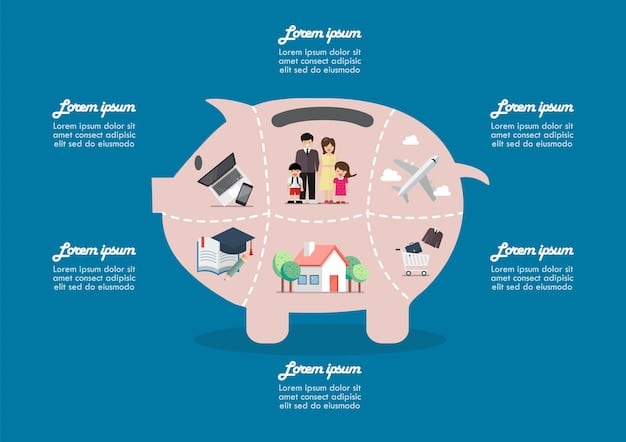Government Shutdown Averted: Budget Deal Impact on US Business & Programs

Averting a potential crisis, Congress has passed a budget deal, temporarily preventing a government shutdown and offering relief to federal programs and businesses in the US, but the longer-term impacts remain a concern for many.
The looming threat of a government shutdown in the US has been averted—at least for now. Congress recently passed a budget deal, providing temporary relief and preventing widespread disruption. But what does this mean for federal programs and the business community? Let’s delve into the details and explore the implications of this agreement.
Understanding the Budget Deal
The bipartisan budget deal recently approved by Congress is designed to keep the government running and avoid a shutdown. While the specifics can be complex, the main goal is to provide temporary funding and set spending levels for various federal programs. Let’s break down the key elements of this agreement.
Key Provisions of the Deal
The budget deal includes several critical provisions that impact different sectors. Understanding these provisions is essential to grasp the broader implications.
- Funding Levels: The agreement sets specific funding levels for various federal agencies and programs, providing a degree of certainty for the short term.
- Debt Ceiling: The deal addresses the debt ceiling, allowing the government to continue borrowing and meeting its financial obligations.
- Spending Cuts: Some spending cuts are included as part of the agreement, though their impact may vary across different programs.
The details of these provisions are constantly evolving, and ongoing negotiations may lead to further changes. Staying informed about these changes can help businesses and individuals prepare for potential impacts.

Impact on Federal Programs
Federal programs touch the lives of many Americans, providing essential services and support. How does this budget deal affect these crucial programs?
Social Security and Medicare
Social Security and Medicare are often at the forefront of budget debates. This deal provides some short-term stability but doesn’t address the long-term challenges facing these programs.
Changes to these programs are politically sensitive and often require careful consideration. For now, beneficiaries can expect services to continue without immediate disruption.
Education and Healthcare
Education and healthcare programs play a vital role in supporting communities and individuals. The budget deal’s impact on these areas varies depending on specific funding allocations.
- Education: Funding for schools and educational initiatives may see adjustments, potentially affecting resources and services.
- Healthcare: Healthcare programs could face changes in funding levels, impacting access and affordability for some individuals.
- Research: Funding for research grants, particularly in health-related areas, may also see some changes.
While the immediate impact may be buffered, it’s important to monitor how these changes affect the quality and availability of services.
Effects on Business Funding and Loans
Businesses rely on various forms of federal funding and loan programs to grow and innovate. How does the budget deal affect these resources?
Small Business Administration (SBA) Loans
SBA loans are a lifeline for many small businesses. Changes in funding levels could impact the availability and terms of these loans.
Entrepreneurs should stay informed about any changes to SBA loan programs to make informed decisions about their financing options.
Grants and Incentives
Federal grants and incentives support innovation, research, and development across various industries. Changes to these programs can affect businesses’ ability to access vital resources.
- Technology: Grants supporting technological advancements could see adjustments, potentially impacting innovation efforts.
- Energy: Incentives for renewable energy projects may also be affected, influencing investment decisions in the energy sector.
Businesses need to carefully evaluate how these changes align with their strategic goals and adjust their plans accordingly.
The Broader Economic Perspective
Beyond specific programs and funding streams, what does this budget deal mean for the overall US economy?
Market Stability
Avoiding a government shutdown provides a sense of stability for financial markets. Uncertainty surrounding shutdowns can lead to volatility and investor anxiety.
By averting a shutdown, the deal helps maintain confidence in the US economy, at least in the short term.
Long-Term Fiscal Challenges
While the budget deal addresses immediate concerns, it doesn’t solve the underlying fiscal challenges facing the US. The national debt remains a significant issue.

Lawmakers will eventually need to address these long-term issues to ensure the country’s fiscal sustainability.
Political Implications and Future Outlook
Budget deals are inherently political, and this one is no exception. What are the political implications, and what does the future hold?
Bipartisan Cooperation
The fact that a bipartisan agreement was reached is a positive sign, but it doesn’t necessarily signal an end to political gridlock. Future budget debates could be just as challenging.
Understanding the political dynamics driving these negotiations is essential for anyone following economic policy.
Potential for Future Shutdowns
This budget deal is only a temporary fix. The underlying issues that led to the threat of a shutdown remain, and future shutdowns are still possible.
- Political Divides: Deep political divides make it difficult to reach consensus on spending and fiscal policy.
- Debt Ceiling Debates: Recurring debates over the debt ceiling create uncertainty and potential disruptions.
Businesses and individuals need to be prepared for the possibility of future fiscal crises.
Strategies for Businesses and Individuals
Given the uncertainty surrounding government funding and fiscal policy, what steps can businesses and individuals take to protect themselves?
Diversify Funding Sources
Businesses should avoid relying too heavily on any single source of funding, especially government programs. Diversification can provide a buffer against potential funding cuts.
Exploring alternative financing options, such as private investors or lines of credit, can help mitigate risk.
Contingency Planning
Develop contingency plans for potential government shutdowns or funding disruptions. This may involve identifying critical services and prioritizing resources.
- Cash Flow Management: Maintain healthy cash flow to weather potential disruptions.
- Communication: Keep stakeholders informed about potential impacts and mitigation strategies.
Taking proactive steps can help businesses and individuals navigate uncertain times.
| Key Point | Brief Description |
|---|---|
| ✅Averted Shutdown | Congress passed a deal to avoid a immediate government shutdown. |
| 💰 Funding Impact | Federal programs and business funding are temporarily secured. |
| 📈 Market Stability | The deal offers short-term stability to financial markets. |
| ⚠️ Long-Term Challenges | Underlying fiscal issues and potential future shutdowns persist. |
Frequently Asked Questions (FAQ)
▼
A government shutdown occurs when Congress fails to pass funding legislation, causing non-essential government services to temporarily cease operations. This impacts a variety of federal agencies.
▼
A budget deal prevents a shutdown by setting funding levels and addressing the debt ceiling, allowing the government to continue operating without interruption. Congressional approval is necessary.
▼
Programs such as national parks, passport services, and some federal agencies often face disruptions during shutdowns. Essential services like law enforcement typically remain operational.
▼
SBA loans provide small businesses with access to capital for startup costs, expansion, and other needs. These loans often have favorable terms that support business growth.
▼
Businesses can diversify funding sources, maintain strong cash flow, and develop contingency plans to mitigate the impact of potential shutdowns. Clear communication is also key.
Conclusion
The recent budget deal provides temporary relief from the threat of a government shutdown, offering stability for federal programs and businesses. However, underlying fiscal challenges persist, and future shutdowns remain a possibility. Staying informed and proactive is essential for navigating these uncertainties.





